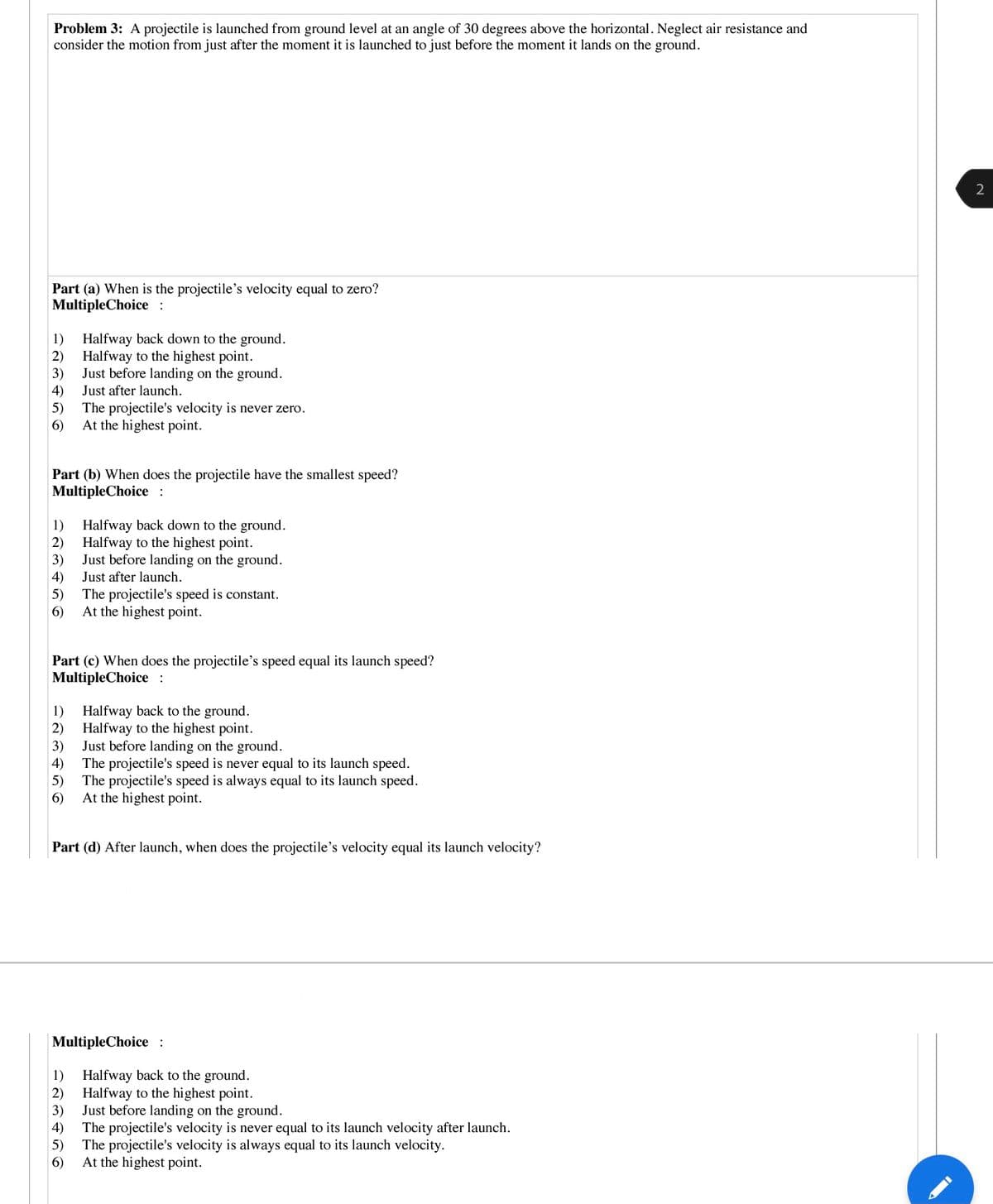Problem 3: A projectile is launched from ground level at an angle of 30 degrees above the horizontal. Neglect air resistance and consider the motion from just after the moment it is launched to just before the moment it lands on the ground. Part (a) When is the projectile's velocity equal to zero? MultipleChoice : 1) Halfway back down to the ground. 2) Halfway to the highest point. 3) Just before landing on the ground. 4) Just after launch. 5) The projectile's velocity is never zero. 6) At the highest point. Part (b) When does the projectile have the smallest speed? MultipleChoice : 1) Halfway back down to the ground. 2) Halfway to the highest point. 3) Just before landing on the ground. 4) Just after launch. 5) The projectile's speed is constant. 6) At the highest point. Part (c) When does the projectile's speed equal its launch speed? MultipleChoice : 1) Halfway back to the ground. 2) Halfway to the highest point. 3) Just before landing on the ground. 4) The projectile's speed is never equal to its launch speed. 5) The projectile's speed is always equal to its launch speed. 6) At the highest point.
Problem 3: A projectile is launched from ground level at an angle of 30 degrees above the horizontal. Neglect air resistance and consider the motion from just after the moment it is launched to just before the moment it lands on the ground. Part (a) When is the projectile's velocity equal to zero? MultipleChoice : 1) Halfway back down to the ground. 2) Halfway to the highest point. 3) Just before landing on the ground. 4) Just after launch. 5) The projectile's velocity is never zero. 6) At the highest point. Part (b) When does the projectile have the smallest speed? MultipleChoice : 1) Halfway back down to the ground. 2) Halfway to the highest point. 3) Just before landing on the ground. 4) Just after launch. 5) The projectile's speed is constant. 6) At the highest point. Part (c) When does the projectile's speed equal its launch speed? MultipleChoice : 1) Halfway back to the ground. 2) Halfway to the highest point. 3) Just before landing on the ground. 4) The projectile's speed is never equal to its launch speed. 5) The projectile's speed is always equal to its launch speed. 6) At the highest point.
Principles of Physics: A Calculus-Based Text
5th Edition
ISBN:9781133104261
Author:Raymond A. Serway, John W. Jewett
Publisher:Raymond A. Serway, John W. Jewett
Chapter3: Motion In Two Dimensions
Section: Chapter Questions
Problem 3P: A particle initially located at the origin has an acceleration of a=3.00jm/s2 and an initial...
Related questions
Concept explainers
Topic Video
Question

Transcribed Image Text:Problem 3: A projectile is launched from ground level at an angle of 30 degrees above the horizontal. Neglect air resistance and
consider the motion from just after the moment it is launched to just before the moment it lands on the ground.
Part (a) When is the projectile's velocity equal to zero?
MultipleChoice :
Halfway back down to the ground.
2)
1)
Halfway to the highest point.
Just before landing on the ground.
3)
4)
5)
Just after launch.
The projectile's velocity is never zero.
6)
At the highest point.
Part (b) When does the projectile have the smallest speed?
MultipleChoice :
Halfway back down to the ground.
2)
1)
Halfway to the highest point.
Just before landing on the ground.
3)
4)
5)
Just after launch.
The projectile's speed is constant.
At the highest point.
6)
Part (c) When does the projectile's speed equal its launch speed?
MultipleChoice :
Halfway back to the ground.
2) Halfway to the highest point.
Just before landing on the ground.
1)
3)
4)
The projectile's speed is never equal to its launch speed.
5)
The projectile's speed is always equal to its launch speed.
6)
At the highest point.
Part (d) After launch, when does the projectile's velocity equal its launch velocity?
MultipleChoice:
1)
Halfway back to the ground.
2)
Halfway to the highest point.
Just before landing on the ground.
3)
4)
The projectile's velocity is never equal to its launch velocity after launch.
5)
The projectile's velocity is always equal to its launch velocity.
6)
At the highest point.
Expert Solution
This question has been solved!
Explore an expertly crafted, step-by-step solution for a thorough understanding of key concepts.
This is a popular solution!
Trending now
This is a popular solution!
Step by step
Solved in 2 steps

Knowledge Booster
Learn more about
Need a deep-dive on the concept behind this application? Look no further. Learn more about this topic, physics and related others by exploring similar questions and additional content below.Recommended textbooks for you

Principles of Physics: A Calculus-Based Text
Physics
ISBN:
9781133104261
Author:
Raymond A. Serway, John W. Jewett
Publisher:
Cengage Learning

Principles of Physics: A Calculus-Based Text
Physics
ISBN:
9781133104261
Author:
Raymond A. Serway, John W. Jewett
Publisher:
Cengage Learning